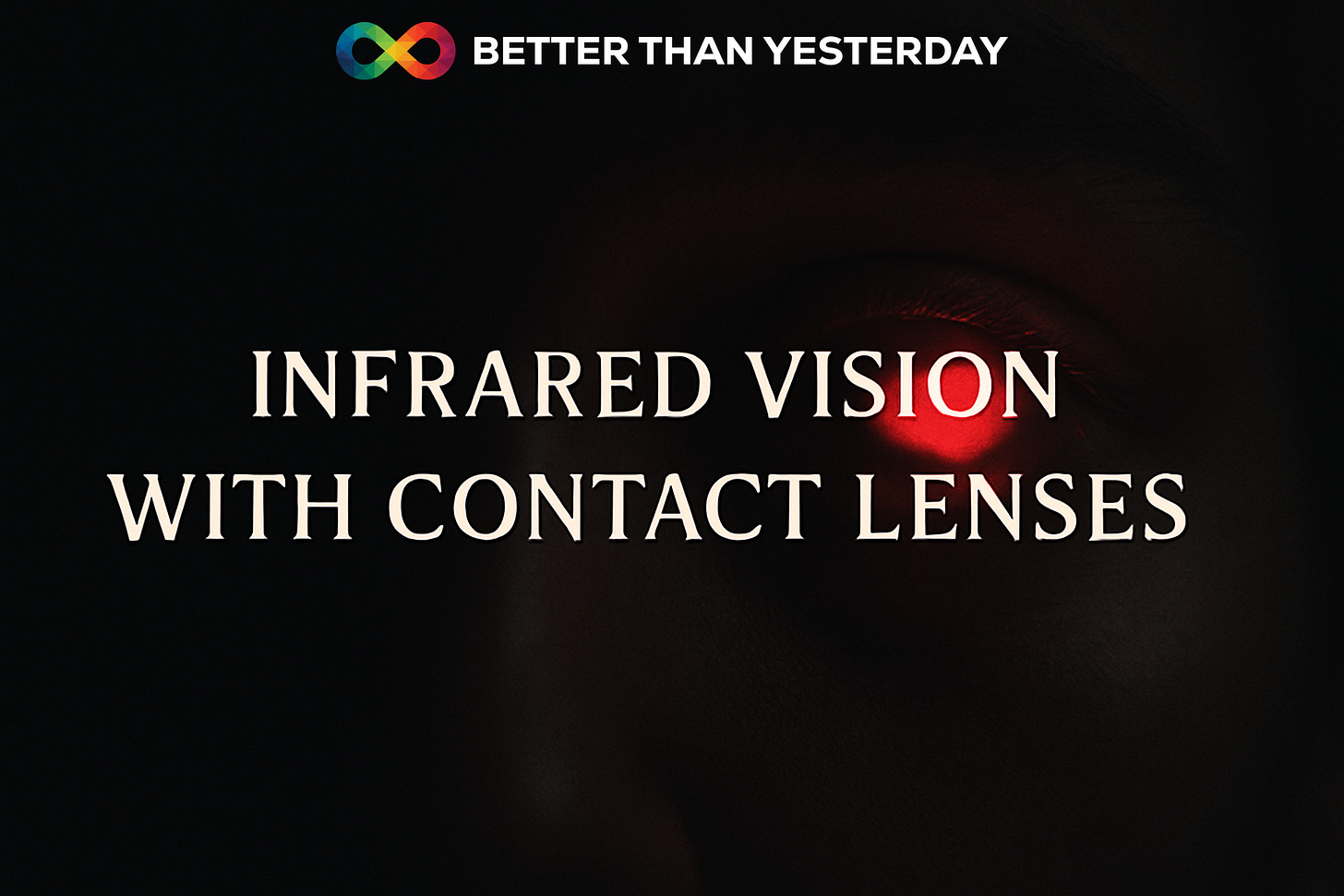The Future is now: Infrared Contact Lenses Are Here.
How this sci-fi-sounding tech is already being tested on humans, and what it could mean for biohackers, color blindness, and the future of human vision.
👁️ Infrared Vision — Now a Reality
Not long ago, night vision meant bulky goggles and batteries.
Now? It fits on your eyeball.
A new study published in Cell introduced contact lenses that let humans see infrared light — with no power source, no implants, and no external hardware. These lenses use embedded nanoparticles that convert near-infrared (800–1600 nm) into visible wavelengths your eyes can detect.
In short: you put in the lens… and suddenly, you see light that’s normally invisible.
And get this — the lenses even work with your eyes closed.
Yeah. Let that sink in. 😳
🔬 How It Works
This isn’t some gimmick or optical trick.
The team behind the tech — a collaboration between neuroscientists and materials scientists in China — embedded upconversion nanoparticles into soft, flexible, non-toxic lens material. These particles absorb near-infrared light and re-emit it in visible wavelengths.
That means:
No need for batteries or wires
Lenses stay clear for regular vision
You can see infrared and visible light at the same time
And because infrared light penetrates eyelid tissue better than visible light, test subjects could actually detect flickering IR signals more clearly with their eyes closed.
That’s not just wild — it’s game-changing.
🧪 What Did the Tests Show?
The research team tested the lenses on both mice and humans. And the results were impressive.
In mice:
They avoided infrared-lit zones when wearing the lenses.
Their pupils reacted to IR light (constriction = detection).
Their visual cortex lit up when IR signals were present.
In humans:
Participants could detect flashing IR signals (like Morse code).
They could sense where the signal was coming from — even with closed eyes.
They performed significantly better with the lenses vs. without.
This isn’t just theoretical. It’s real infrared perception.
🎯 Why It Matters for Biohackers
You might be wondering: cool science, but why should I care?
Because this kind of tech blurs the line between biology and hardware. It’s wearable, passive, and enhances what the body can do without surgery or energy inputs.
Here’s what that opens up:
✔️ Secure communication
Flickering IR patterns invisible to the naked eye could be used to transmit coded messages.
✔️ Color blindness support
They’re already engineering versions that convert colors — turning “unseen” red tones into green, for example.
✔️ Thermal awareness
Different wavelengths of IR correspond to heat levels. With color-coded nanoparticles, you could start seeing temperature differences.
✔️ Rescue operations + night navigation
Imagine walking through a dark forest and spotting an IR beacon — no headlamp needed.
✔️ Biofeedback & self-monitoring
If this tech evolves, it could allow visual feedback from wearable sensors in real time — via light patterns only you can perceive.
🎨 The Future: Color-Coded IR Vision
One of the most promising upgrades? The team added a twist: color-coded IR detection.
808 nm = green
980 nm = blue
1532 nm = red
With these trichromatic lenses, you don’t just see IR… you see it in color. That means the brain can distinguish different IR sources more easily.
And beyond that, it opens the door to new types of vision. Visual overlays. Pattern detection. Even signals the rest of the world doesn’t know are there.
🤖 Will This Be Mainstream?
Not yet. The lenses currently only detect IR emitted by LED sources. That means no "Predator vision" from ambient heat just yet.
But the team is working on:
Boosting sensitivity to lower IR levels
Improving resolution (scattering is a current issue)
Expanding spectrum range
Testing long-term safety and comfort
They’ve even developed a high-res glasses version using the same material — a step toward accessibility and broader real-world use.
🧬 Big Picture: What This Signals
This isn’t about seeing in the dark.
This is about changing the inputs your brain receives — extending the human sensorium.
It’s the same shift we saw with:
Night vision goggles
Heart rate trackers
Blood glucose monitors
AR displays
But this time… it’s passive, discreet, and directly wearable.
It’s one more step toward human augmentation without surgery or implants.
And it’s happening fast.
👁️ Takeaway
Infrared contact lenses aren’t sci-fi anymore.
They’re in lab tests, on human eyes, showing real results.
It’s still early — but the vision is clear (literally).
This kind of wearable neurotech could redefine how we perceive light, communicate, navigate, and adapt. And for those of us interested in longevity, resilience, and upgrading human limits…
…it’s worth watching very closely.
—
🧬 Subscribe to Better Than Yesterday for daily science-backed biohacking & longevity insights you won’t hear from your doctor.
🌿 https://t.me/DailyBiohacking



